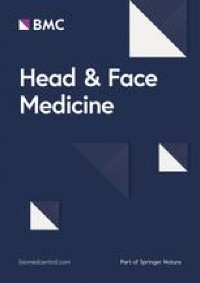|
Medicine RSS-Feeds by Alexandros G. Sfakianakis,Anapafseos 5 Agios Nikolaos 72100 Crete Greece,00302841026182,00306932607174,alsfakia@gmail.com
Πληροφορίες
Πέμπτη 3 Ιουνίου 2021
Incidence of Anosmia among Covid 19 patients in India
A novel scoring system based on small vestibular schwannomas to determine consideration for cochlear implantation
|
Locoregional Recurrence in p16‐Positive Oropharyngeal Squamous Cell Carcinoma After TORS
|
ANLN promotes carcinogenesis in oral cancer by regulating the PI3K/mTOR signaling pathway
|
Ototoxicity of Artemisinin-Based Combination Therapy: A Case Presentation
|
Patient-reported opioid use for tissue expander-based breast reconstruction
|
Combined Transcranial-endonasal Reconstructive Surgery for Cerebrospinal Fluid Leakage Resulting from Traumatic Anterior Skull Base Fractures Involving the Parasellar Region
|
Brain pharmacokinetics of two BBB penetrating bispecific antibodies of different size
|
Caffeine metabolites are associated with different forms of caffeine supplementation and with perceived exertion during endurance exercise
|
Effect of Microvascular Decompression of the Vagus Root Entry/Exit Zone on Blood Pressure in Patients with Hemifacial Spasm Associated with Essential Hypertension: A Retrospective Clinical Analysis
|
Gamma Knife Radiosurgery for Large Vestibular Schwannoma More Than 10 cm3: A Single-Center Indian Study
|
Αρχειοθήκη ιστολογίου
-
►
2023
(366)
- ► Φεβρουαρίου (184)
- ► Ιανουαρίου (182)
-
►
2022
(2814)
- ► Δεκεμβρίου (182)
- ► Σεπτεμβρίου (213)
- ► Φεβρουαρίου (264)
- ► Ιανουαρίου (262)
-
▼
2021
(3815)
- ► Δεκεμβρίου (229)
- ► Σεπτεμβρίου (276)
-
▼
Ιουνίου
(441)
-
▼
Ιουν 03
(25)
- Incidence of Anosmia among Covid 19 patients in India
- A novel scoring system based on small vestibular s...
- Locoregional Recurrence in p16‐Positive Oropharyng...
- ANLN promotes carcinogenesis in oral cancer by reg...
- Ototoxicity of Artemisinin-Based Combination Thera...
- Patient-reported opioid use for tissue expander-ba...
- Combined Transcranial-endonasal Reconstructive Sur...
- Brain pharmacokinetics of two BBB penetrating bisp...
- Caffeine metabolites are associated with different...
- Effect of Microvascular Decompression of the Vagus...
- Gamma Knife Radiosurgery for Large Vestibular Schw...
- Direct Clipping of Paraclinoid Aneurysm in Conjunc...
- Primary Dural Repair Using Titanium Microclips Fol...
- Operative Anatomy of the Skull Base: 3D Exploratio...
- Association between pulmonary function and cardiac...
- ABO system combination with Rh, Kell and MN group ...
- Proinflammatory cytokines as potential risk factor...
- Diagnostic accuracy of reticulocyte parameters on ...
- Cutaneous methotrexate-related T-cell lymphoprolif...
- Association of Hematologic biomarkers and their co...
- Lower hair cortisol among patients with sickle cel...
- Hospital acquired infection in a department of hem...
- Eltrombopag post autologous hematopoietic stem cel...
- Anti-globulin test positivity indicates advanced d...
- Transverse plane ultrasound-guided caudal epidural...
-
▼
Ιουν 03
(25)
- ► Φεβρουαρίου (64)
-
►
2020
(5754)
- ► Δεκεμβρίου (401)
- ► Σεπτεμβρίου (365)
- ► Φεβρουαρίου (754)
- ► Ιανουαρίου (894)
-
►
2019
(146)
- ► Δεκεμβρίου (19)
- ► Σεπτεμβρίου (54)





